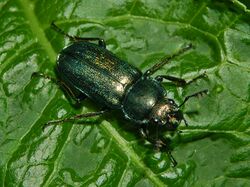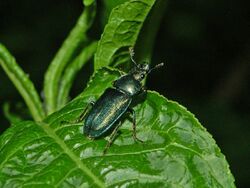Biology:Platycerus caraboides
| Platycerus caraboides | |
|---|---|

| |
| Platycerus caraboides. Male | |
| Scientific classification | |
| Domain: | Eukaryota |
| Kingdom: | Animalia |
| Phylum: | Arthropoda |
| Class: | Insecta |
| Order: | Coleoptera |
| Family: | Lucanidae |
| Genus: | Platycerus |
| Species: | P. caraboides
|
| Binomial name | |
| Platycerus caraboides | |
| Synonyms | |
| |
Platycerus caraboides is a species of stag beetle belonging to the family Lucanidae, subfamily Lucaninae.
Subspecies
Subspecies include: [1]
- Platycerus caraboides caerulosus Didier & Ségui, 1953
- Platycerus caraboides caraboides (Linnaeus, 1758)
Distribution
These beetles are present in most of Europe (Albania, Austria, Belgium, Bosnia and Herzegovina, Bulgaria, Croatia, Czech Republic, Denmark , Finland , France , Germany , Hungary, Italy, Luxembourg, the Republic of North Macedonia, Montenegro, Netherlands, Norway , Poland , Romania, Russia , Serbia, Slovakia, Slovenia, Spain , Sweden, Switzerland , Ukraine and United Kingdom ), in Asia (China , Iran, Kazakhstan, Syria, Turkey) and in North Africa (Algeria, Morocco, Tunisia) [2]
Description
Platycerus caraboides can reach a body length of about 9–13 mm (0.35–0.51 in). These beetles have flat body, metallic black, steel blue or greenish. Antennae are geniculate, with a club of 3 items, Jaws are denticulate at the inner edge and also in the male they are shorter than the head.[3] This species can be easily distinguished as a stag beetle by its geniculate (elbowed) antennae.
This species is very similar to Platycerus caprea (De Geer, 1774).
File:Platycerus caraboides - 2012-05-08.ogv
Biology
Adults can mostly be encountered from May through July, flying around during the day in deciduous forests or staying on the ground on rotten branches. The predominantly host-plants are broadleaf plants, but also conifers (mainly Pinus species). The larvae usually live on decayed wood of oak and beech. [3]
References
| Wikimedia Commons has media related to Platycerus caraboides. |
- ↑ Biolib
- ↑ Fauna Europaea
- ↑ 3.0 3.1 Scarabeidi (in Italian)
Wikidata ☰ Q610399 entry
 |


